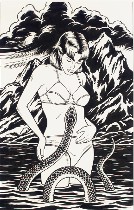
The Pennsylvania Academy of Fine Arts has just opened a major drawing show filled with wit and vision (left, local comic book artist Charles Burns‘ front cover drawing for ‘Black Hole,’ issue #7).
It’s part of the good news of some of the things going on at PAFA.
The show is “Light, Line and Color,” 237 works on paper from PAFA’s collection, some of which are brand new, some of which have never been seen, and some of which have not seen for a generation. It’s in the new Fisher Brooks Gallery on the first floor of the new Hamilton Building, a gargantuan space that has been reconfigured into more manageable spaces (see my post on the space when it opened).
The really good news is that this exhibition marks the first major curatorial effort here by PAFA Assistant Curator Robert Cozzolino. Cozzolino (see Roberta’s post including some words on Cozzolino and his arrival) said when we took the tour of the exibit on Friday that his academic field of interest is recent painting and graphic arts. But right after he arrived at PAFA, he was assigned this show. He admitted his surprise but then ran with it, examining each of the 12,000 paper pieces in the archive. He has created a coherent and ebullient show that traces art historical themes in American prints and drawings and other paper media while incorporating plenty of what is going on in paper today.
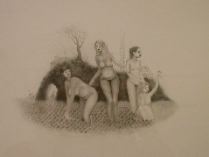 To have gotten a curator of this quality with this ability to view the past and the present is just great news for PAFA and Philadelphia (right, local artist Randall Sellers’ postmodern take on bathers, “Untitled 4,” pencil on Bristol paper, 5 x 7 inches, from the Figure Study part of the show. Sellers shows at Spector Gallery).
To have gotten a curator of this quality with this ability to view the past and the present is just great news for PAFA and Philadelphia (right, local artist Randall Sellers’ postmodern take on bathers, “Untitled 4,” pencil on Bristol paper, 5 x 7 inches, from the Figure Study part of the show. Sellers shows at Spector Gallery).The tour
Cozzolino chatted away as he took a small group of us, including Roberta and me, around the exhibit. Occasionally, the exigencies of last-minute installation issues drew him away as we ambled around the gallery, but the show stood on its own without need of pumping up, and Cozzolino proved to be a source of all sorts of information, like the number of pieces in the Academy’s paper archives–12,000 pieces. “I went through everything, every flat-file drawer.”
Cozzolino said the exhibit is “a snapshot of the strengths of the collection.”
There’s not much overlap with the last such survey, curated in 1986 (by Kathleen Adair Foster, who is now curator of American art at the Philadelphia Museum of Art). The lack of overlap between the two exhibits is partially because since then PAFA has “bought really well and has gotten great gifts,” Cozzolino said. Those additions all make the collection more cohesive, he added. “I’ve also bought to fill in gaps. And [PAFA Curator of Contemporary Art] Alex Baker, who buys contemporary art, has bought some since September.”
Looking at the bright side of what it means to have small budget to spend on art, Cozzolino said, “We can do works on paper really well and show what the academy tradition has really meant.”
The show is divided into six sections. (I have to confess I gave The Academic Tradition section short shrift.) We started with portraits and self-portraits. One of the images making its debut here is the John Singleton Copley “Portrait of John Scollay,” (acquired in 1987, too late for the previous show).
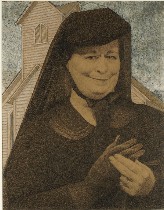 Nearby, an outstanding Grant Wood, “The Good Influence,” is a portrait of the town gossip in the book “Main Street,” for which Wood did a series of drawings. The subject is painted with a wicked twinkle in her eye, in the background a church that looks a lot like the one in Wood’s “American Gothic.” The funny juxtaposition of the holy and unholy zings along with the stylized graphic punch and cartoony portraiture that also make “American Gothic” such an icon (left, “The Good Influence,” black carbon pencil, India ink and white gouache, about 31 x 24 inches).
Nearby, an outstanding Grant Wood, “The Good Influence,” is a portrait of the town gossip in the book “Main Street,” for which Wood did a series of drawings. The subject is painted with a wicked twinkle in her eye, in the background a church that looks a lot like the one in Wood’s “American Gothic.” The funny juxtaposition of the holy and unholy zings along with the stylized graphic punch and cartoony portraiture that also make “American Gothic” such an icon (left, “The Good Influence,” black carbon pencil, India ink and white gouache, about 31 x 24 inches).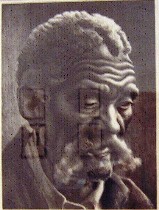 Other highlights were “Aaron,” an outstanding portrait of a heavily lined face with corrugated forehead by Thomas Hart Benton, and Red Grooms’ “Portrait of Fritz,” a reminder of that underneath his cartoon exterior, Grooms is a German Expressionist. A pair of disturbing magical realist drawings from Pavel Tchelitchev and John Wilde are both recent acquisitions. Nearby, Wilde’s notebook documenting his nervous breakdown as a soldier in World War II is shown here for the first time (right, “Aaron” by Benton, a 1941 lithograph, about 13 x 10 inches).
Other highlights were “Aaron,” an outstanding portrait of a heavily lined face with corrugated forehead by Thomas Hart Benton, and Red Grooms’ “Portrait of Fritz,” a reminder of that underneath his cartoon exterior, Grooms is a German Expressionist. A pair of disturbing magical realist drawings from Pavel Tchelitchev and John Wilde are both recent acquisitions. Nearby, Wilde’s notebook documenting his nervous breakdown as a soldier in World War II is shown here for the first time (right, “Aaron” by Benton, a 1941 lithograph, about 13 x 10 inches).A trip through time and taste
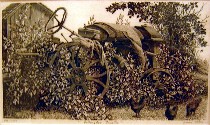 The section Rural Vistas and Urban Spaces told a number of stories, including industrialization and its affect on both the landscape and the city, and the changing tastes in landscape subjects and painting styles.
The section Rural Vistas and Urban Spaces told a number of stories, including industrialization and its affect on both the landscape and the city, and the changing tastes in landscape subjects and painting styles.
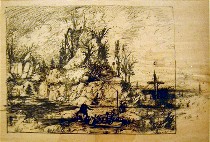 Grace Arnold Albee’s “Entangled Tractor,” from 1945, as well as influential artists’ artist Marshall Glasier’s “Fantastic Landscape” together with the more visionary Charles Ephraim Burchfield’s loopy watercolor and charcoal “Purple Vetch and Buttercups” (aargh, this one’s a period piece) belies the terms “realism” and “landscape” and reinforces the limitless ability of imagination (Albee’s tractor wood engraving, above left, and Glasier’s pen and ink landscape, right).
Grace Arnold Albee’s “Entangled Tractor,” from 1945, as well as influential artists’ artist Marshall Glasier’s “Fantastic Landscape” together with the more visionary Charles Ephraim Burchfield’s loopy watercolor and charcoal “Purple Vetch and Buttercups” (aargh, this one’s a period piece) belies the terms “realism” and “landscape” and reinforces the limitless ability of imagination (Albee’s tractor wood engraving, above left, and Glasier’s pen and ink landscape, right).
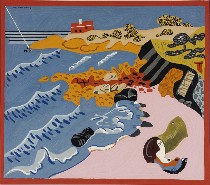
Near the Burchfield, Stuart Davis’ idyllic “Sand Cove,” which is the signature image for the show’s banners and brochure, is a beauty and nothing like the jazzy geometric work for which he is known.
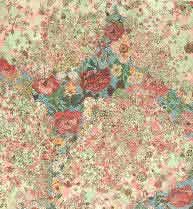
In some ways, this painting, with its patterns and designs, is more like the Kate Abercrombie print from the Philadelphia Print Collaborative than like any of the landscapes in the show (left, Davis’s gouache “Sand Cove,” and right, Abercrombie’s untitled mixed media print; Abercrombie shows at Vox Populi).
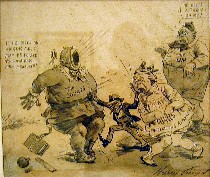 The urban views included a terrific political cartoon from Herbert Johnson, “Yes, These Gangster Assaults on Helpless Babes Should Make Us Real Cross,” made for the Saturday Evening Post ca. 1930-44. Cozzolino, whom we had lost for a while, turned up as we gazed at the Johnson. “I’d love to do a Herbert Johnson show,” he mentioned. He admitted to having lists of shows he was dreaming of based on his explore of the deep deep archives (left, Johnson’s cartoon).
The urban views included a terrific political cartoon from Herbert Johnson, “Yes, These Gangster Assaults on Helpless Babes Should Make Us Real Cross,” made for the Saturday Evening Post ca. 1930-44. Cozzolino, whom we had lost for a while, turned up as we gazed at the Johnson. “I’d love to do a Herbert Johnson show,” he mentioned. He admitted to having lists of shows he was dreaming of based on his explore of the deep deep archives (left, Johnson’s cartoon).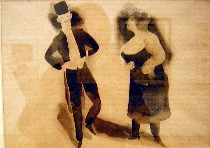 A non-precisionist painting from Charles Demuth, “Vaudeville Dancers,” had the power to surprise, especially with a more typical precisionist piece right nearby. Cozzolino offered some gossip–that Demuth, a diabetic, was not taking care of himself, but Dr. Albert Barnes got him into regular treatments (right, “Vaudeville Dancers”).
A non-precisionist painting from Charles Demuth, “Vaudeville Dancers,” had the power to surprise, especially with a more typical precisionist piece right nearby. Cozzolino offered some gossip–that Demuth, a diabetic, was not taking care of himself, but Dr. Albert Barnes got him into regular treatments (right, “Vaudeville Dancers”).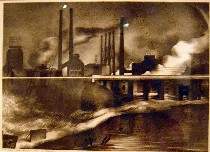
A nearby group of coal and industry related prints and paintings also caught my eye, including “Koppers Coke” by Victoria Hutson Huntley, Willie Birch’s “Promise Land” (which was a gift of the Brandywine Workshop in 1989, by the way), and Alfred Leslie’s “Coal Pile near the Ohio River” (left, “Koppers Coke” lithograph).
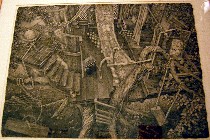
Well, at this point, even with the checklist of works, I’ve lost my sense of categories. So let me just say I loved Janet E. Turner’s “Black Vultures” linocut and Stuart Homer Frost’s “The Tree House” pen-and-ink, which both stopped me dead in my tracks. (Maybe these are visionary landscapes, a category I cannot find on my checklist). I don’t know if Paul Santoleri (now showing at Projects Gallery until July 31) is familiar with Frost, but they have a lot in common with eachother as well as with MC Escher in their approach to the spatial (right, “The Tree House”).
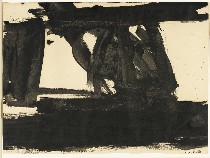 The Language of Abstraction section included a small, intense Franz Kline, “untitled,” the delicate, Asian-inspired “Memory of the Rains in Uruapan” by Sonia Sekula, and a small Lenore Tawney, “Mother of All Aeons,” a woven paper collage with a cosmic sky (left, Kline’s “Untitled” pen and ink).
The Language of Abstraction section included a small, intense Franz Kline, “untitled,” the delicate, Asian-inspired “Memory of the Rains in Uruapan” by Sonia Sekula, and a small Lenore Tawney, “Mother of All Aeons,” a woven paper collage with a cosmic sky (left, Kline’s “Untitled” pen and ink).At this point I fell right off the categories, but who cares? There’s so much terrific work in this show that I just want to give it a thumbs up.
Modern times
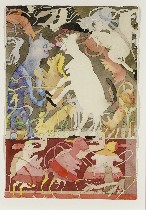
But let me blab about a few more things: The hilarious “Pussy and Herbert: Their Second Date” by Gladys Nilsson comes out of the Hairy Who. It’s an image of people as cartoony animals with sweet pink genitals doing the dance of romance (right, “Pussy and Herbert: Their Second Date”).

Speaking of the Hairy Who, Cozzolino mentioned that PAFA just bought a “great Jim Nutt” from 1969 from Fleisher-Ollman Gallery. It’s a reverse painting on a window shade, he said, and gallery still has it–up now at Art Basil.
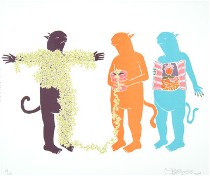
Nilsson’s playful psycho-sexual watercolor is right near three terrific local items from the 2004 Philadelphia Print Collective collection–Ben Woodward’s lithograph “Whatever it Takes,” Charles Burwell’s silkscreen “Variations,” and the Kate Abercrombie mentioned before (above left, Burwell’s “Variations;” Burwell shows at Sande Webster Gallery; and right, Woodward’s “Whatever it Takes”; Woodward shows at Spector Gallery).
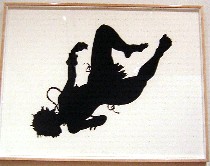
Contemporary Strategies includes the terrific Charles Burns at the top of the post, two flip books from Richard Tuttle that are anything by flip and my fave, an outrageous Kara Walker printed silhouette, “African/American,” a recent purchase, which talks to a 1910 proper silhouette portrait of “William Merritt Chase” by Kate P. Parker nearby. Walker’s bush-woman commentary on racial and sexual stereotypes, positioned just a few feet away from all those traditional nudes in poses of simpering false modesty serves as a nice reaffirmation that contemporary art is not about preserving tradition any more than it’s about rejecting it. That’s a false dichotomy. It’s about transforming tradition so it says something fresh, important and pertinent in a way that’s new. In art, like in all communication, the medium is the message(left, “African/American,” 1998, linocut, 46 x 60 1/2 inches, printer’s proof from edition of 60).









